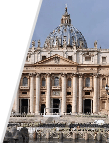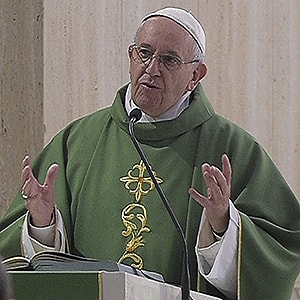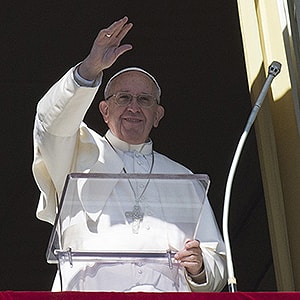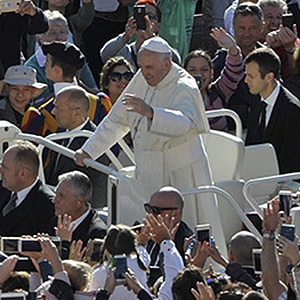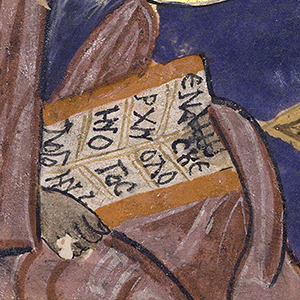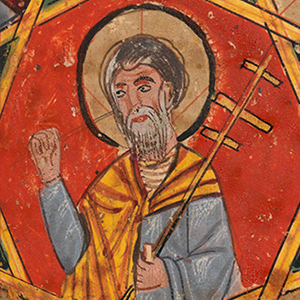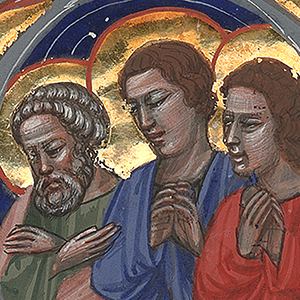
Solemnity of the Most Sacred Heart of Jesus
The Solemnity of the Most Sacred Heart of Jesus – also the World Day of Prayer for the Sanctification of Priests – is celebrated on the Friday after the Solemnity of Corpus Christi. This suggests to us that the Eucharist (Corpus Christi) is none other than the Heart of Jesus himself, of the One who “takes care of us” with his “heart”.
On 20 October 1672, Father Giovanni Eudes, a priest from Normandy, celebrated this feast for the first time. But there had already been several German mystics that had begun cultivating devotion to the Sacred Heart of Jesus in the Middle Ages: Mechtild of Magdeburg (1212-1283), Mechtilde of Hackeborn (1240/1-1298) and Gertrude of Helfta (1256-1302) – and the Dominican, Blessed Henry Suso (1295 – 1366).
But to popularize the devotion, the revelations of our Lord to the Visitation nun of the convent of Paray-le-Monial, Margaret Mary Alacoque (1647-1690), contributed greatly. Margaret Mary had entered the French convent in Saône-et-Loire in 1671. She already had the reputation of being a mystic when on 27 December 1673 she received the first vision of Jesus who invited her to take John’s place, the only apostle who physically rested his head on Jesus’s chest, among those present at the Last Supper. “My Divine Heart is so passionately in love with humanity that it can no longer contain within itself the flames of its ardent love. It must pour them out. I have chosen you for this great plan,” Jesus told her. The following year, Margaret had two other visions. In the first, Jesus’s heart was on a throne enveloped in flames brighter than the sun and more transparent than crystal, surrounded by a crown of thorns. In the other, she saw Christ shining in glory. Flames of fire were coming out of every part of his chest to the point that it looked like a furnace. Jesus spoke to her and asked her to receive Communion every first Friday for nine consecutive months and to prostrate herself on the ground for an hour the night between Thursday and Friday. This is how the practice of the nine first Fridays originated and the Holy Hour of Adoration. Then in a fourth vision, Christ asked for the institution of a feast to honour his Heart and to make reparation through prayer for offenses received.
Pope Pius IX made it an obligatory feast throughout the universal Church in 1856. In 1995, Saint John Paul II instituted the World Day of Prayer for the Sanctification of Priests on this same day so that the priesthood might be protected in the hands of Jesus, rather in his heart, so it could be open to everyone.
- Anno A
- Anno B
- Anno C
At that time Jesus said in reply, “I give praise to you, Father, Lord of heaven and earth, for although you have hidden these things from the wise and the learned you have revealed them to the childlike. Yes, Father, such has been your gracious will. All things have been handed over to me by my Father. No one knows the Son except the Father, and no one knows the Father except the Son and anyone to whom the Son wishes to reveal him. Come to me, all you who labor and are burdened, and I will give you rest. Take my yoke upon you and learn from me, for I am meek and humble of heart; and you will find rest for yourselves. For my yoke is easy, and my burden light.” (Mt.11:25-30)
The childlike in the Gospel
The liturgy presents one of Jesus’s rare prayers when he “blesses” his Father in heaven. He publicly recognizes how much his Father has done and is doing toward the “childlike”, rather than to the wise and the learned. The content of what has been revealed is contained in the expression, “you have hidden these things”. From what can be gleaned from the preceding verses, “these things” are Jesus’s own understanding which was opposed by the “wise and the learned”. On the other hand, the “childlike” could be the “poor” to whom he proclaimed the Gospel, as well as the “lowly ones”, or those who listened to and welcomed his Word. A key to understanding the Most Sacred Heart of Jesus is understandable only to the extent that one becomes “lowly”, “humble”.
My yoke is easy
A yoke is a device used to harness animals. It is placed around the necks of one or more draught animals, subduing them, attaching them to a vehicle or machine which is maneuvered by an operator. Using this experience drawn from agricultural life, Jesus invites the “childlike” to trust in him who guarantees rest, peace, liberation because his yoke is not oppressive. Jesus does not overburden those who drawn near to him. He does not oppress them by making them bear burdens that the rabbis of his time would not even use a finger to help them lift. Jesus, humble and pure of heart, is the One who does what he says, the One who accepts the will of the Father and personally lives it, and helps the “childlike” carry out that will as well. This is why Jesus’s yoke is easy, not because it is “watered down”, but because he removed the legalistic encrustations and restored God’s law to its origins, revealing that God is merciful love. His love is everlasting, Psalm 136 reminds us.
The Heart
When we hear the word “heart”, we think above all about affections, emotions, sentiments. It has a much broader meaning in biblical language. It indicates the entire person in his or her awareness, intelligence, freedom. The heart indicates the interior reality of the person, as well as our desire to think. It is the seat of memory, the centre where choices are made, projects come to fruition. Through his open side, Jesus shows us and says to us: “I am interested in you”, “I take your life to heart”. Likewise, he says: “Do this in memory of me”… take care of others with your heart. In other words, have the same sentiments as I do, make the same decisions I do, knowing how to be “meek and humble of heart”.
Prayer
Divine Heart of Jesus,
I offer you through the Immaculate Heart of Mary,
Mother of the Church,
in union with the Eucharistic Sacrifice,
my prayers, actions, joys and sufferings of this day
in reparation for sins and for the salvation of all people,
in the grace of the Holy Spirit for the glory of the Heavenly Father.
Amen.
Now since it was preparation day, in order that the bodies might not remain on the cross on the sabbath, for the sabbath day of that week was a solemn one, the Jews asked Pilate that their legs be broken and they be taken down. So the soldiers came and broke the legs of the first and then of the other one who was crucified with Jesus. But when they came to Jesus and saw that he was already dead, they did not break his legs, but one soldier thrust his lance into his side, and immediately blood and water flowed out. (Jn 19:31-34)
Blood and water
When the solder reached Jesus, seeing he was already dead, he did not break his legs. But one of the soldiers struck him with a lance, and blood and water immediately flowed out. This detail suggests how much this scene impressed the evangelist.
Jesus had already spoken of water in the context of the gifts of Baptism and the Holy Spirit given to believers: “On the last and greatest day of the feast, Jesus stood up and exclaimed, “Let anyone who thirsts come to me and drink. Whoever believes in me, as scripture says: ‘Rivers of living water will flow from within him.’” He said this in reference to the Spirit that those who came to believe in him were to receive. There was, of course, no Spirit yet, because Jesus had not yet been glorified” (Jn. 7:37-39).
And the gift of his blood symbolizes the Eucharist “Whoever eats my flesh and drinks my blood has eternal life, and I will raise him on the last day. For my flesh is true food, and my blood is true drink. Whoever eats my flesh and drinks my blood remains in me and I in him” (Jn. 6:54-56). This almost suggests to us under what form he would continue being present on earth.
The Heart
When we hear the word “heart”, we think above all about affections, emotions, sentiments. It has a much broader meaning in biblical language. It indicates the entire person in his or her awareness, intelligence, freedom. The heart indicates the interior reality of the person, as well as our desire to think. It is the seat of memory, the centre where choices are made, projects come to fruition. Through his open side, Jesus shows us and says to us: “I am interested in you”, “I take your life to heart”. Likewise, he says: “Do this in memory of me”… take care of others with your heart. In other words, have the same sentiments as I do, make the same decisions I do, knowing how to be “meek and humble of heart”.
Prayer
Divine Heart of Jesus,
I offer you through the Immaculate Heart of Mary,
Mother of the Church,
in union with the Eucharistic Sacrifice,
my prayers, actions, joys and sufferings of this day
in reparation for sins and for the salvation of all people,
in the grace of the Holy Spirit for the glory of the Heavenly Father.
Amen.
Jesus addressed this parable to the Pharisees and scribes: "What man among you having a hundred sheep and losing one of them would not leave the ninety-nine in the desert and go after the lost one until he finds it? And when he does find it, he sets it on his shoulders with great joy and, upon his arrival home, he calls together his friends and neighbors and says to them, 'Rejoice with me because I have found my lost sheep.' I tell you, in just the same way there will be more joy in heaven over one sinner who repents than over ninety-nine righteous people who have no need of repentance." (Lk. 15:3-7)
The paradox of the Gospel
It is a paradox to abandon 99 sheep to go in search of one that is lost at the risk of losing the entire flock! And yet, Jesus reminds us in the Gospel, this is God’s logic. It is the logic of “mercy”. God’s Heart is not satisfied with the joy of the 99 knowing that one is missing, is lost. This compassionate heart moves the “good shepherd” to search for the lost one. In the end he puts it on his shoulders and brings it back home. This gesture is not accidental. At that time having found a “lost” sheep, a leg would be broken so it would learn not to stray from the flock. Jesus, the good shepherd, is the One who carries it on his shoulders instead, giving it what it really needs: tenderness and mercy. This, Jesus reminds us, is the heart of God himself. And when he carries the sheep on his shoulders, we remember how he took the cross on his shoulders for all of us who are “lost”.
Joy
A second aspect that is worth noting is the joy in the air at the feast that takes place on returning home. There is no atmosphere of rebuke or fear, but of a joy that even makes the neighbours participate. This joy is only a “sign” of what will explode in Heaven when we get there. Celebrating the Solemnity of the Most Sacred Heart of Jesus means harmonizing ourselves with his care, with how he makes himself close so that not even one sheep remains lost along the paths of history. Allowing him to draw near requires the attitudes of trust and mercy.
The Heart
When we hear the word “heart”, we think above all about affections, emotions, sentiments. It has a much broader meaning in biblical language. It indicates the entire person in his or her awareness, intelligence, freedom. The heart indicates the interior reality of the person, as well as our desire to think. It is the seat of memory, the centre where choices are made, projects come to fruition. Through his open side, Jesus shows us and says to us: “I am interested in you”, “I take your life to heart”. Likewise, he says: “Do this in memory of me”… take care of others with your heart. In other words, have the same sentiments as I do, make the same decisions I do, knowing how to be “meek and humble of heart”.
Prayer
Divine Heart of Jesus,
I offer you through the Immaculate Heart of Mary,
Mother of the Church,
in union with the Eucharistic Sacrifice,
my prayers, actions, joys and sufferings of this day
in reparation for sins and for the salvation of all people,
in the grace of the Holy Spirit for the glory of the Heavenly Father.
Amen.



